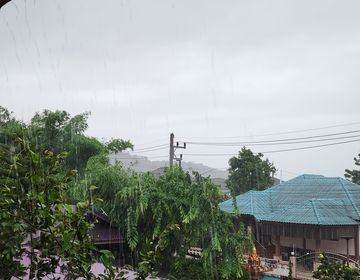Learning to Speak the Thai Language Without the Classic Language Apps
As a language aficionado, when I decided to move to Thailand, I figured learning Thai would come with time and patience. I knew it would not be easy, but I was somehow confident I would learn it. I would simply click the plus button on my Duolingo account and add Thai as a new lang--... Wait, Thai is not available on Duolingo... or Rosetta Stone or Babbel. That was something I had not anticipated. Not only could I no longer rely on the apps I was familiar with, but I soon discovered how few resources there are available to learn Thai, especially in comparison to the other foreign languages I have learned in the past.
It took me until about four months into my contract to commit to learning Thai beyond the basics and specific words. I am still far away from considering myself a proficient speaker of the Thai language. However, at this point, I can order at a restaurant, introduce myself, communicate basic ideas to my motorbike and taxi drivers, and ask for a discount when shopping at a market. However, I only speak Thai and did not tackle learning the Thai script, so I can't read it. Instead, my notes from my daily Thai lessons (self taught) are rough transliterations of Thai from the main app I use, Mango, and numbers to indicate the correct tone for that word.
Learning Thai is by no means easy, but hopefully, with a list of resources, the prospect of learning Thai may at least feel more attainable. I would also like to mention, that this list of resources comes from a girl who likes to save all her money to travel, meaning I do not spend money to learn Thai. Therefore, this list is the free resources I could compile!
My Approach to Learning Thai
Initially, I thought I would learn Thai by starting with an app, specifically with Ling. However, I lost motivation after just the first lesson. Instead, I began learning Thai when I arrived in Thailand by asking friends how to say certain things in Thai and mastering the basics. Below is the order in which I learned Thai:
- Learn the basic phrases of Thai.
- Learn a basic understanding of how the Thai language works.
- Learn specific and relevant phrases and numbers.
- Learn via a language learning app.
10 Most Basic Thai Phrases
I am taking this list from a previous post of mine, The Ultimate Pre-Departure Checklist for Teaching in Thailand. These are the bare minimum basics you need to know to start you off when you get to Thailand.
- Sawadee Krab (for males) OR Sawadee Ka (for females): Hello/ Goodbye
- Khob Khun Krab (for males) OR Khob Khun Ka (for females): Thank you
- Kob kun mak: Thank you very much
- Chai: Yes
- Mai chai: No
- Mai pen rai: You’re welcome/It’s okay
- Hong nam yoo tee nai?: Where is the bathroom?
- Pet: Spicy
- Mai pet: Not spicy
- Arroy (maak): (very) delicious
Basic Understanding of the Structure of Thai Language
- Use of Krap/ Ka: Thai people use the words “krap” or “ka” at the end of sentences to make a sentence more formal or polite. “Krap” is used at the end when the speaker is a man, and “ka” when the speaker is a woman. For example, saying hello in Thai is “sawadee” but is always said politely, so for men, it is “sawadee-KRAP” and for women, “sawadee-KA”
- Tonal Language. Thai had five tones which you can see below. Maybe it is an unpopular opinion, but the tones are the least of my worries thus far. Since my Thai is at the beginner level and sentences are simple, people understand what I am trying to say through context, even if my pronunciation is not perfect.
- Thai rarely use pronouns, articles, or prepositions and do not conjugate verbs. The Thai language is by no means easy to learn, but in this regard, it is simpler than English. In many conversations, you rarely use the words I or you in a sentence because everyone infers that you are talking about yourself or someone else. Thai also does not have a/an or the and uses just one conjugation for verbs. Lastly, in cases where in English we would say, “I am going to Bangkok,” in Thai, it would simply be, “Go Bangkok.”
Learn Specific and Relevant Phrases from People, YouTube, and Instagram
Below is a list of different resources, including posts/ reels from Instagram, vocabulary lists from ThaiPod101 (with native speakers saying the phrase so you can hear), YouTube videos, and any other resources I could find. I believe there is so much to learn from these videos, and they can even substitute subscription apps. If you go with this route, I recommend downloading the Anki application (https://apps.ankiweb.net/) and learning through practicing flashcards daily. You can download it for free on your laptop, and I would only aim to learn three words a day.
- Giving Directions from Instagram: I follow LearnThaiWithMai and learn a lot from her. In this specific video, she goes over how to say: “Go to ____”, “turn left,” “Turn right,” “Go straight,” “Stop here,” “Stop at __,” and “How much?”
- Ordering Food (basics) from Instagram: In this Insta video, LearnThaiWithMai goes over how to say “I would like” and “without/ do not put (chilies, ice, etc.)”, “can I get the bill.”
- Ordering Food Vocab List from ThaiPod101 (difficult).
- Ordering at a coffee shop from the website LearnThaiFromAWhiteGuy.
- Ordering beer from the website LearnThaiFromAWhiteGuy.
- Here, There, Over There from Instagram.
- Learning Numbers from ThaiPod101 and practicing numbers with this fun game. Bonus if you want to learn how to write the Thai numbers 1-9 from Instagram.
- Months of the Year from ThaiPod101.
- Days of the Week from ThaiPod101.
- Talking About Time in Thai from ThaiPod101.
- Fruits and Vegetables from ThaiPod101.
- Names of Various Drinks (Alcoholic, Soda, and Juice) from ThaiPod101.
- Thai Drinks from small local carts from Instagram.
- Paying (asking to pay with cash, QR code, credit card, and more).
- Vocabulary for getting a Thai Massage from the website LearnThaiFromAWhiteGuy.
- Vocabulary to use with motorbike drivers (telling drivers where to stop and asking them to slow down) from YouTube.
- Vocabulary to speak with Taxi Drivers (including how to ask to turn on the meter, use the expressway, and ask to turn on the air-conditioning) from YouTube.
- Asking "where is the bathroom" from Instagram.
- Asking and answering "where are you going" from Instagram.
Learning Via Apps on Smartphones or Online
My favorite app for learning Thai is called Mango Languages. Now, here is the thing, and do not freak out. Mango is, unfortunately, a subscription app. I know I know, I said I would only give you a free way to learn Thai, and now it seems I am gaslighting you. I may or may not be. I get to learn through Mango for free because I have logged in with my public library card, and I am not the only one! I have met a handful of people who use Mango through their public library, and there is a high chance you also can! Think about your hometown library and university and check to see if you can! I think the app is worth it.
Here’s why I love Mango Languages. I tried other language-learning apps like Nemo (for smartphones), Ling, and ThaiPod101.com (for browsers), and Mango stuck out to me for three reasons:
- They do not trick you into a half-free app. With Mango, you either subscribe or you do not. Once you are in, there are not any scams to make you pay more. Meanwhile, Nemo, Ling, and ThaiPod101 will all give you some basic beginner lessons for free and then ask that you pay. I would want to use a Thai language learning app to practice more with specific situations like paying for items, ordering at a restaurant, etc., and Nemo and Ling require you to pay to unlock those sections. Meanwhile, Mango lets you jump around to whatever chapter is most relevant to you, and you do not have to "unlock" any section.
- Very organized. The app has ten different chapters with topics, such as Places and Directions, Food and Drink Culture, and Salutations and Small Talk. Mango is easy to use and gives a clear, step-by-step method to learning rather than choosing between dozens upon dozens of lessons.
- They break up phrases and teach the words step by step. On Ling, they teach words in Thai and then put them in these long sentences that overwhelm me. Mango, on the other hand, starts the lesson with a longer phrase like, Can I have the bill, please, and then goes step by step into introducing how to say bill and can. It makes me understand the language easier and more in-depth.
- Flashcards that automatically update every day. Mango uses the spaced repetition method to ensure you do not forget the words you already learned by creating daily flashcards. When you learn a new word, they will make you review it first thing the next day, but as you can remember that word or phrase easier, they test you on it less frequently until it stays in your long-term memory. Brilliant if you ask me.
If you can not access Mango for free through your library, it costs $11.99/ month. If you do not want to pay for apps, I stand by my first method: learning Thai via Thai people, YouTube, and Instagram.
Why Learn Thai
I have said it before, and I will say it again: learning Thai is not easy. Every day for the last two weeks before I left the US to come to Thailand, I wrote down “start learning Thai” on my to-do list, but did I do it? No. With a lack of resources and motivation to learn while still being in a culture that speaks English, I could not bring myself to do it. Even when I got to Thailand, it was easy to use English, especially since my city is urban and touristy.
However, starting to learn Thai has integrated me more into Thailand and Thai culture. From learning the basics of Thai, I feel much closer and understand my students' struggle in learning English; I know why they make the mistakes they do because I realize that Thai does not have concepts for ideas in the English language (and vice versa).
Speaking Thai has also made traveling and exploring Thailand even more enjoyable. I recently traveled around the north of Thailand via motorbike and often found myself in smaller and more rural areas. Wherever I traveled through, I felt confident that I could get any essentials I needed without Google Translate. I felt much more connected with the local community when I got to speak my broken Thai, and in those moments, I thought to myself, “Wow, I'm really doing it. I'm living in Thailand.”
You do not have to plan on being fluent in Thai. I do not. I do, however, plan on knowing Thai well enough to have simple and basic conversations (a bit beyond the level I currently speak). Maybe one day I will tackle learning the Thai script, but maybe I won’t. However far you plan on learning Thai is completely up to you. All I can speak for is my experience, which is that my time in Thailand has become even richer from my efforts and small daily habits, and I hope that others can share this feeling of joy, pride, and a sense of accomplishment as well.
Related Posts
Embrace the Rain: Challenges Bring Growth
Challenges are like the rain, it may not be our most favorite thing, but so worth it in the end, as we allow ourselves to grow.
Beginners Guide to Teaching in Thailand: Preparing For Your First Week
I talked a little bit about Thai schools in comparison to American schools in a previous blog post of mine, Understanding Thai School Culture: Two Weeks in Pattaya. In that... keep reading
Introduction to Simba
Hi all! I'm Simba, and I'm currently teaching in Thailand for a year. This post is just a little something to share about myself and why I decided to join... keep reading


